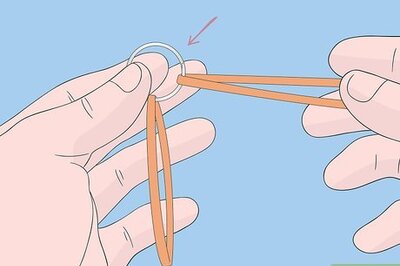
views
Russia’s Sputnik V, the world’s first vaccine registered against the coronavirus disease (Covid-19), has been recommended for emergency use by experts in India. Soon, it is likely to get the final nod as the country’s third vaccine — after Bharat Biotech’s Covaxin and Oxford-AstraZeneca’s Covishield — at a time when there is a worrying spike in cases linked to the viral infection.
So what is Sputnik V?
In leading peer-reviewed medical journal The BMJ, Chris Baraniuk reviewed the vaccine in a paper published on March 19. “By the time the World Health Organization declared Covid-19 a pandemic in early March 2020, the Gamaleya National Center of Epidemiology and Microbiology in Moscow was already working on a prototype of Sputnik V, funded by the Russian Direct Investment Fund (RDIF), the country’s sovereign wealth fund,” this paper said.
Sputnik V, which shares its name with the world’s first artificial satellite made by Russia, is an adenovirus-based vaccine (more on this later) that is being used by Moscow for mass vaccination. Russian President Vladmir Putin has said one of his daughters had already had two doses of the vaccine. It has also been approved in 59 countries with a total population of over 1.5 billion people.
How does it work?
The vaccine, also known as Gam-Covid-Vac, is a combination of two different adenoviruses (Ad26 and Ad5). The adenoviruses — viruses that cause common cold — are combined with the SARS-CoV-2 (the virus that causes Covid-19) spike protein, which prompts the body to make an immune response to it, according to The BMJ paper cited above. Using the same adenovirus for the two doses could lead to the body developing an immune response against the vector and destroying it when the second dose is administered. Two different vectors reduce the chance of this, it said.
“The SARS-CoV-2 virus is studded with proteins that it uses to enter human cells. These so-called spike proteins make a tempting target for potential vaccines and treatments,” a New York Times (NYT) report explained. Researchers added the gene for the coronavirus spike protein to Ad26 and Ad5, and engineered them so they could invade cells but not replicate, the report said.
“Sputnik V comes out of decades of research on adenovirus-based vaccines. The first one was approved for general use last year — a vaccine for Ebola, made by Johnson & Johnson. Some other coronavirus vaccines are also based adenoviruses, such as one from Johnson & Johnson using Ad26, and one by the University of Oxford and AstraZeneca using a chimpanzee adenovirus,” it added.
Idea behind adenovirus vaccines
A report in the Radio Free Europe/Radio Liberty (RFERL), a US-funded publication, explained this. “Sputnik V is a viral-vector vaccine. That means that it uses a modified version of a different virus as a tool to transport genetic material to a cell. Sputnik V was developed using adenoviruses, which normally causes respiratory infections, but other viruses (including the influenza or measles virus) have also been used in other viral-vector therapies,” it said.
The report explained that the virus, which is used as a vector, is altered so it poses no threat of causing an illness. The report added that it is inserted with an extra gene that is unique to the virus being targeted. For Covid-19 vaccines, this gene contains instructions on how to make a spike protein, which is found on the surface of the coronavirus.
Once a person gets the vaccine, the vector enters a cell and uses it to make spike proteins. As soon as the immune system recognizes the spike proteins, it starts producing antibodies and activates other immune processes in the body. If the system interacts with the actual virus in the future, it already knows how to fight it.
Comparison with Covishield and Covaxin
Covishield, the Oxford-AstraZeneca vaccine being manufactured by the Serum Institute of India, follows the same philosophy. It “is made from a weakened version of a common cold virus (known as an adenovirus) from chimpanzees. It has been modified to look more like coronavirus – although it can’t cause illness,” according to a BBC report.
Covaxin, on the other hand, is an inactivated vaccine — which means that it is made up of killed coronaviruses, making it safe to be injected into the body. “Bharat Biotech used a sample of the coronavirus, isolated by India’s National Institute of Virology. When administered, immune cells can still recognise the dead virus, prompting the immune system to make antibodies against the pandemic virus,” the BBC report said.
A separate NYT report said Covaxin works by teaching the immune system to make antibodies against the SARS-CoV-2 coronavirus. “The antibodies attach to viral proteins, such as the so-called spike proteins that stud its surface,” it added.
“Inactivated viruses have been used for over a century. Jonas Salk used them to create his polio vaccine in the 1950s, and they’re the bases for vaccines against other diseases including rabies and hepatitis A.”
Is Sputnik V effective?
President Putin surprised the world and the scientific community by announcing Russian approval for emergency use of Sputnik V as early as August 2020. The BMJ’s assessment of the vaccine said phases I and II results, “on 76 participants of an open, non-randomised trial, were published in the Lancet in September”. According to the paper, all participants developed SARS-CoV-2 antibodies and that no serious adverse events were detected.
“Interim phase III data were published in early February 2021. The randomised, double blind, placebo controlled trial included nearly 22 000 adults aged 18 years or older recruited through 25 hospitals and clinics in Moscow between 7 September and 24 November 2020. Each participant received either two doses of the vaccine, or a placebo, which were administered 21 days apart,” The BMJ said.
Interim results (based on data so far from 14 964 participants in the vaccine group and 4902 in the placebo group) indicate that the vaccine is 91.6% effective, based on its ability to prevent symptomatic infection, the paper added.
Read all the Latest News, Breaking News and Coronavirus News here. Follow us on Facebook, Twitter and Telegram.




















Comments
0 comment